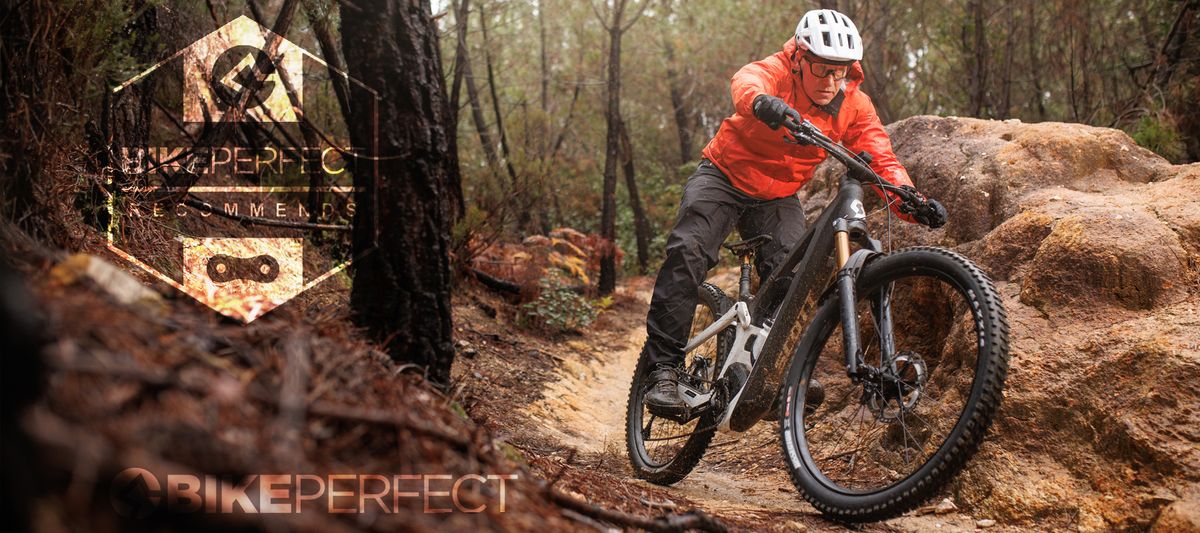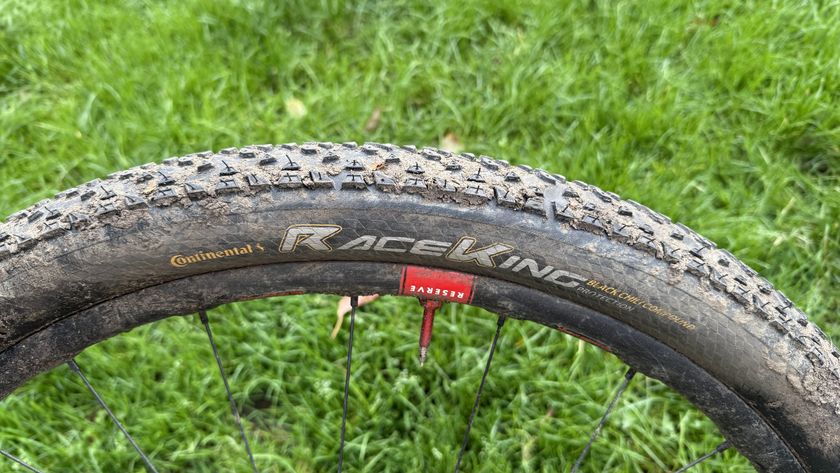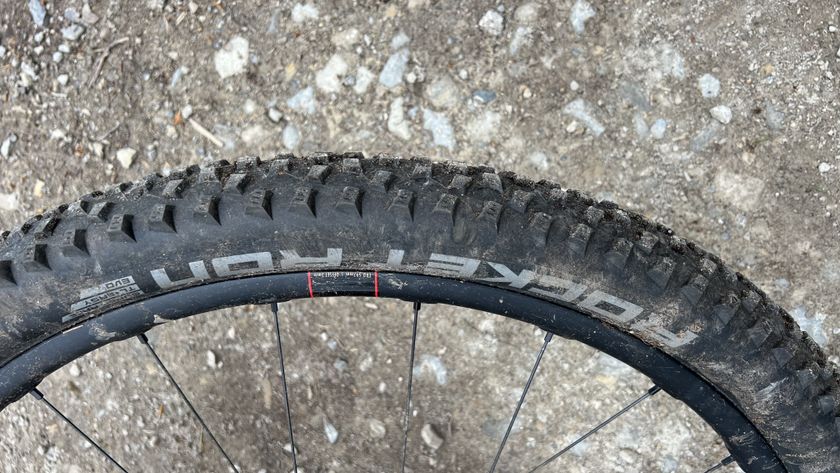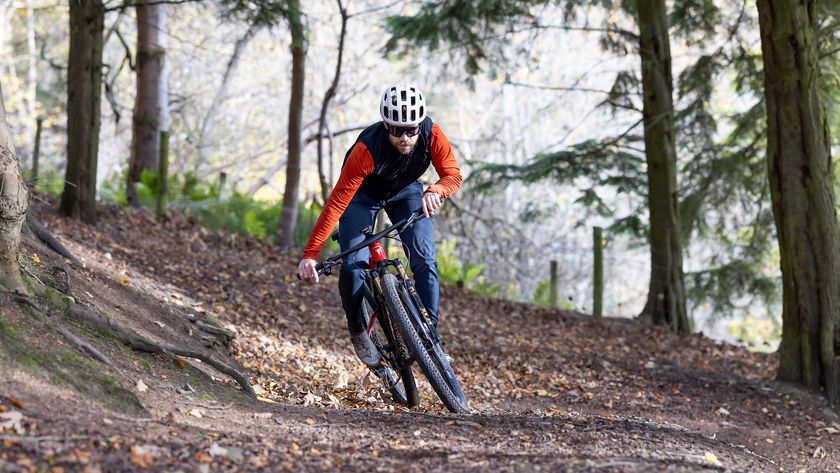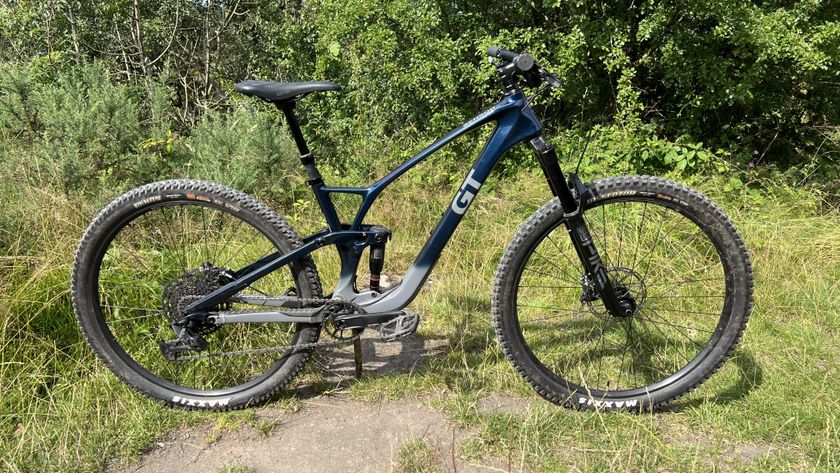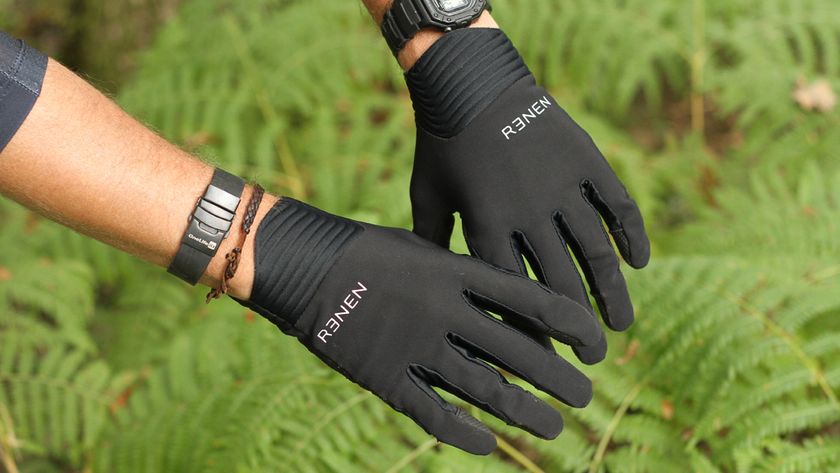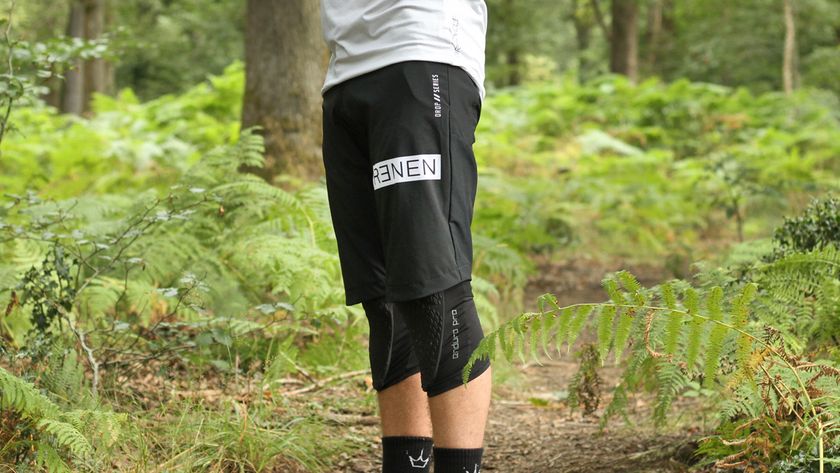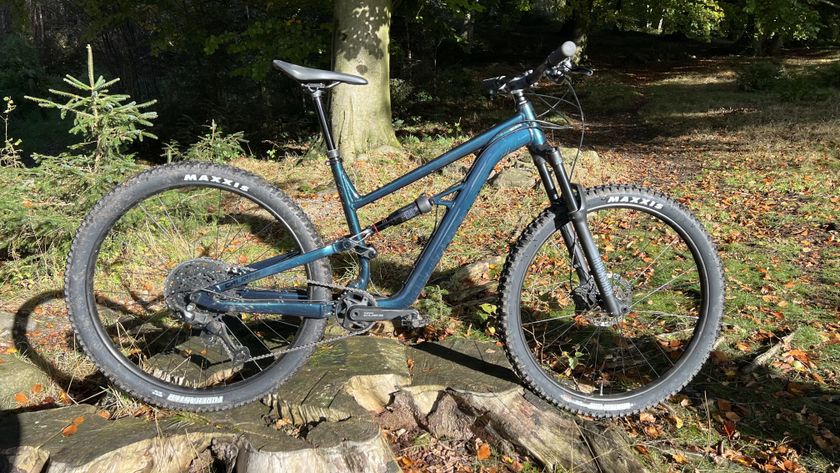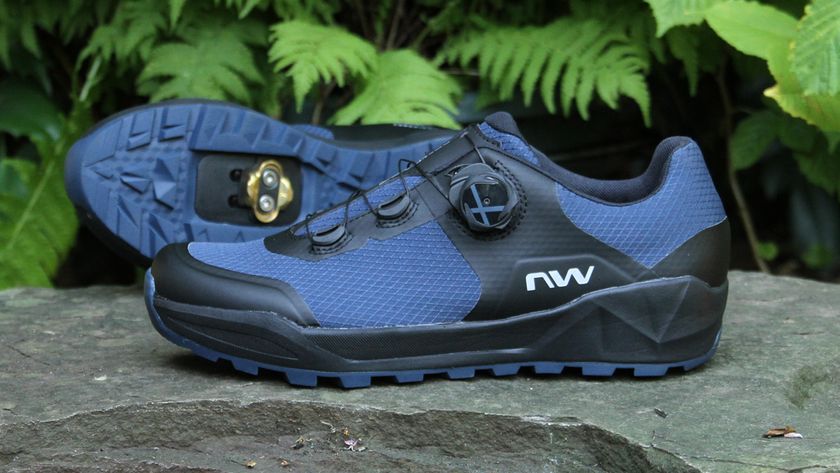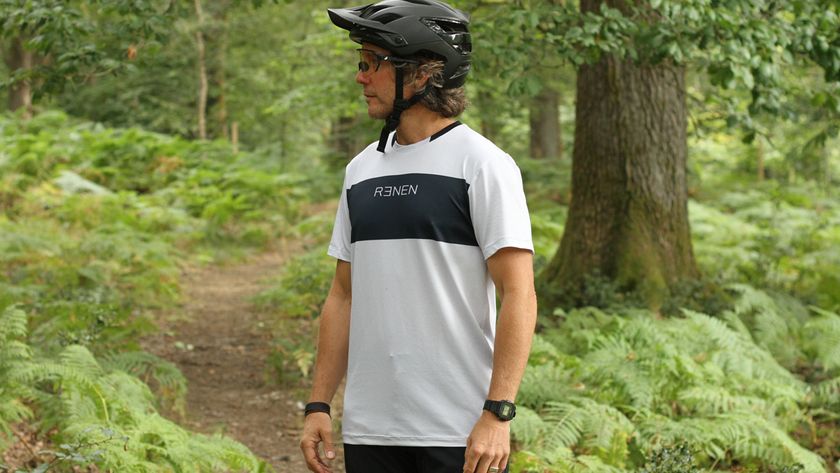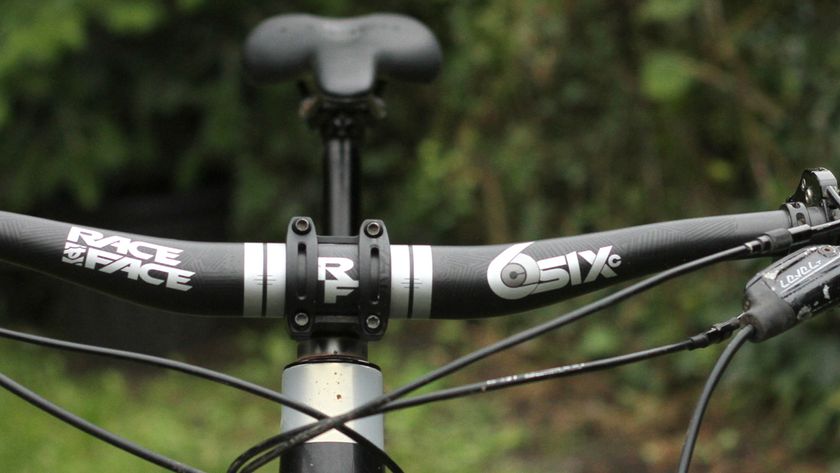Early Verdict
Behind the futuristic integrated design, Scott's patron is a practical all-mountain e-bike that's a fantastic climber and very balanced and engaging on a wide range of terrain. The Bosch motor and 750Wh battery offer smooth powerful assistance and a massive range to take on all-day adventures too. Not all riders will want Scott's features like the TwinLoc lock-out though, and while the sophisticated integration looks slick, it also introduces extra faff in the initial suspension set-up
Pros
- +
Well balanced ride with predictable and lively handling that's more like a normal bike
- +
Superb climber with supportive pedaling and excellent traction
- +
Bosch Gen4 system has excellent power and massive range with its 750Wh battery
- +
Futuristic looks
Cons
- -
Hidden shock is harder to set up
- -
Rats nest of handlebar cables due to TwinLoc system
- -
Suspension could be more supportive
- -
Futuristic looks
Why trust BikePerfect
Scott presumably named its new e-bike the Patron in a nod to a mafia don that bosses all the local turf they survey. That’s clearly the game plan here too; to create the best electric mountain bike for handling all the ups and downs you chuck at it and, thanks to a massive 750Wh battery and latest-generation Bosch Performance CX motor, do it all day long.
Not that you’d immediately know what drive system this futuristic-looking e-bike uses at first glance, owing as it does more to Tesla-generation design, rather than anything as boring as a simple mountain bike with a motor and battery bolted on as an afterthought.
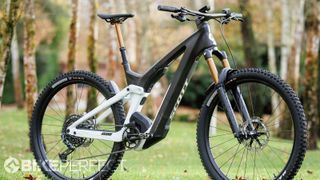
Design and aesthetics
The stocky but super-clean shapes also hide the shock out of plain sight. The Fox NUDE shock Scott uses as part of its lock-out system is lurking inside the top tube behind a plastic door and driven by a clever scissoring linkage system that penetrates the frame.
This three-piece link system uses a chunky knurled interface that’s a primary benefit of a patent Scott recently purchased from fellow Swiss brand Bold - similar technology allows the brand’s new Spark trail bike to hide its shock inside its seat tube too.
There’s 160mm travel front and rear to match the Patron’s all-mountain game-plan, and while the design language might be completely new, Scott still offers its opinion-dividing TwinLoc2 system mentioned above. Via a busy handlebar remote with three levers (including the dropper remote) and too many cables, this can fully lock out the suspension or activate a middle ‘Traction Control’ setting. The latter cleverly reduces travel to 115mm and raises the BB to tip the rider forwards for a better climbing position and extra ground clearance to avoid pedal strikes. It all works effectively and has become a well-refined Scott trademark over the years. My take on it is that it’s more logical on analog bikes, and whether you need a lockout on a hugely powerful e-bike with very stable pedaling manners is up for debate. That said, most of us don’t have the luxury of the endless uphill grades that some Scott customers will.
Bosch’s latest drive system comes with the huge 4.3kg 750Wh battery paired to new software and its latest bar controller. Its new Kiox 300 display here offers a stack of color-coded statistics but isn’t actually essential if you prefer a cleaner cockpit. Am I alone in wishing Bosch offered a more minimal controller too like Specialized or even Shimano that takes up less bar real estate, though? I’m not really a fan of all the info on the Kiox display and the fiddly controller combined with a rats nest of twin lock levers and cables means there’s way too much going in at the handlebars for a minimalist like me. But, then again, I’m not the type to sweat the stats or fiddle with app settings and know a lot of riders love their dials and fettling opportunities.


The motor manufacturer claims brands are also demanding ever more range, so developed its new motor on maximum power and mileage – Bosch hasn’t dipped into toes into the ‘lightweight’ e-bike segment yet. This means here, like all other 2022 Bosch bikes, the ‘full-fat’ label is real and while the better-packed cells in the Gen4 battery will undoubtedly last for many kilometers and meters of elevation, with no lighter option, it’s inevitable e-bikes like this continue to get heavier - Bosch’s 85Nm system works great with a ton of torque, but wasn’t part of the ‘issue’ with e-bikes always that they were excessively heavy in the first place?
Anyway, this philosophical issue isn’t Scott’s problem, and, thankfully, the brand has set about addressing it in the best way possible; namely by getting whatever weight there is in the best possible place.
The entire Patron game-plan is based around tackling optimum weight distribution and getting the heaviest components as low as possible. This means motor and battery go as low as possible, achieved by rotating the motor upwards like the Whyte E-150 S e-MTB, and then being flexible with where other lighter parts like the shock go – hence the internal top tube box for Fox’s NUDE damper (that’s an essential part of the Twin Loc 2 set up). The brand claims 55 per cent of the system weight is in the middle portion of the bike and the cradled-from-underneath motor mounting means a clever vented cover dumps heat from the motor on hotter days for better operation too.
The patron is available in four sizes and three construction configurations, all sharing the same basic silhouette and principles. Medium frame weights are as follows: Carbon 2.97kg, Hybrid 3.38kg and Alloy 4.46kg.
All models can fit a 2.6in rear tire, even with shorter 454mm chainstays compared to the E-Genius predecessor. There’s obviously still the option to go narrower for slightly more precise handling and a lower bottom bracket height compared to the 347mm static standard - something I’d actually likely do myself for a UK setup to cut through mud and slime better. The lower bottom bracket should also make the Patron feel more dynamic in corners, as it’s not the nimblest most ‘corner-schralping’ e-bike around.
The all-new design means all four sizes can have the same kinematic and disguise the shock and battery to maintain the futuristic look, and another benefit of the internal shock is Scott could use a bigger model with more oil volume and keep it protected from grit and crud on the trails.


One drawback with it, however, is being significantly harder to set and check sag when you have to twist around underneath to try and look deep into the top tube - a torch and plenty of patience are needed if you want to delve deeper into air pressure than the rudimentary plastic sag meter on the side (that a mate will still need to read for you). Rebound is admittedly easy to twiddle with the tool-free door opened.
There’s not only better carbon compaction in the new chassis; geometry is also much improved over its predecessor too. Longer lower and slacker are familiar improvements these days, but the chainstays here are also significantly (11mm) shorter and the whole frame sits lower with shorter seat tubes in all sizes, which is noticeably good when you’re chucking the bike about on the trails.
Alongside the new geometry, Scott claims the construction is so much stiffer than before, there’s 45 per cent less deflection between the front and rear halves compared to the alloy E-Genius. It’s also very neat how the battery lives inside in a plastic tube that keeps it quiet and easy to remove for off-the-bike charging. There’s even a safety toggle to stop the battery from falling out onto your toes, which has happened before on Whyte’s less refined design.
Upfront, the Patron’s huge headtube uses the latest 1.8in tapered steerer tube on forks that are designed to stand up to e-bikes' huge loads and twisting forces. The 38 fork is steered by another of Scott’s proprietary technologies, namely the Syncros Hixon one-piece carbon bar and stem. This thing looks neat and the shape is good, but does mean if you aren’t a fan of the fixed stem length (50mm on S & M and 60mm on L and XL) or the 780mm width or sweep, then it’s a lot of money and faff changing the whole set up. The bar height is adjusted by clip-on spacers that also keep the cables needed by TwinLoc tidy by piping them inside the oversized headtube. I personally would have preferred a shorter stem on the size Large, as I’m used to sub 50mm stems on all my bikes.
The frame also has a built-in rear fender with light that could prove useful, but I’m not totally convinced motor manufacturers are best saving even small percentages of battery power for features that not all mountain bikers will need.


Components and build
In terms of other parts, there’s an effective mix, but the crispy 12-speed GX drivetrain sneaks in a few cheaper pieces like an NX chain. The Maxxis Dissector tires roll fast but aren’t the best in UK mud with a wide space between central and shoulder lugs that can feel vague at lean angles. Scott also uses 28-spoke Syncros wheels, but the rims must be really strong as I didn’t see any issues myself or in a big group riding rocky trails in Spain at the Patron launch. The XT four-pot brakes worked great at stopping the 24kg machine too.
In terms of suspension, Fox controls damping at both ends with an oversized 38 FIT4 fork and a special 205 x 65mm Nude DPS shock developed alongside Scott. There’s 17 per cent progression overall and 100 per cent anti-squat in sag position, and lower anti-squat deeper in the stroke to keep the suspension active.
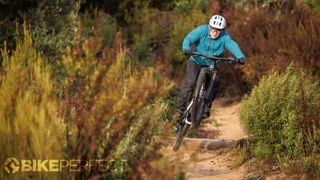
Performance
The Patron pedals very smoothly with next to no bob or wallowing and there’s a really snappy feel that sees you fly along flatter singletrack and flowy trails when you crank with the aid of that powerful Bosch motor.
Pointing downhill, the suspension is very balanced – if you get the rebound dialed in, both fork and shock are well synchronized and predictable. There’s a more linear feel at both ends than some bikes and I saw plenty of journalists adding the maximum six-volume spacers to the 29-er FIT4 fork to get more support. I’d prefer the superior GRIP2 damper on a heavy e-bike, but that’s not possible as Scott needs to tap into the lockout option of FIT4 for its TwinLoc feature. It’s also quite easy to occasionally smash through all the rear travel – although I only noticed it landing flat or stoving into uphill rock faces on technical trails.
The bike does stay very composed even when you’re cracking on though with an easy to ride and easy to adjust vibe that never felt weird. It’s also stiff and solid with no sense of flimsiness that sees it keep going exactly where you point it, however gnarly the terrain is. Another plus is the Patron absolutely loves climbing uphill and the pedal support is great riding up ridiculously steep challenges with the 165mm cranks sitting a tad higher than some e-bikes so ground strikes and snags are less of an issue. The Bosch system works as well as you’d expect too with absolutely tons of power and torque, plus the big battery goes on and on – it’s rated for 2,000m of climbing in ECO mode according to Scott.
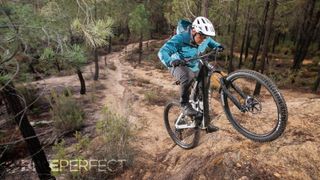
Like any heavy, long-range e-bike the Patron hasn’t got the chuckability of lighter machines, or some e-bikes like YT’s Decoy or Nukeproof’s Megawatt that, even with more travel, feel more agile and nimble. It does hide its bulk well though and can move about the trail with good energy, plus all the dynamism in the world won’t get you very far if you’re 50km from home and have no battery left, whereas the huge 750Wh power plant here has got your back for huge days out.
Basically, the Patron feels more like the e-trail bike it’s designed to be, disguising its weight very well where it matters most on the fun bits and will prove a versatile do-it-all rig for the all-mountain rider who doesn’t need to shred every downhill within an inch of its life.
One issue I did have at the launch was my lower shock bushing came loose after a full day’s riding, but Scott is aware of it and will be replacing the Fox IGUS bush with a more durable brass sleeve on production versions. The shock cupboard is also slightly less low profile than it could be due to the need to allow room for the sticky-out dials on the X-Fusion shock on the cheapest model. Everything else worked flawlessly.
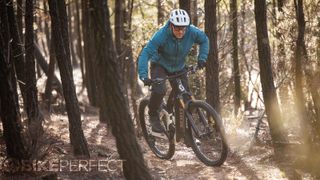
Verdict
The Patron kept me safe and calm riding virgin trails at a fair old lick and has a well-balanced drama-free ride. It doesn’t give you that rip-and-pop ride that rails turns or bounces out of berms like a more progressive bike with a super low BB might, but this arguably makes it a more friendly all-rounder. It’s easy to ride and an amazing climber that’s never too mushy or glued to the floor.
While some might look to the totally enduro focussed E-Ransom which is better suited to getting the juices salivating for hardcore shredders, this Patron will suit the majority of Scott’s customers to a tee without any nasty habits to put you off.
At $8,999.99 / £8,149.00, the futuristic looks don’t come cheap though, but that isn't surprising when you are buying into a machine that’s way closer in spirit to a Tesla than an original knobbly-tired Marin County mountain bike from forty years ago.
Tech Specs: Scott Patron eRIDE 900 Tuned
- Price: $8,999.99 / £8,149.00
- Model: Scott Patron eRIDE 900 TUNED
- Discipline: Trail/Enduro
- Head angle: 65-degrees
- Frame material: Patron eRIDE Carbon frame
- Size: Large
- Weight: 24kg (claimed)
- Wheel size: 29 x 2..6in
- Suspension: Fox 38 Float Factory Air (160mm) and Fox Nude T eRIDE EVOL rear shock
- Drivetrain: SRAM GX 12-speed
- Cranks: SRAM X1, 165mm, 34T chainring
- Brakes: Shimano XT 4 pot brakes with 203 rotors
- Cockpit: Syncros Hixon iC SL integrated cockpit
- Wheelset: Syncros Revelstoke-E 1.5 CL
- Tires: Maxxis Dissector 29x2.6 tires
- Seatpost: Fox Transfer Factory Dropper Post
- Saddle: Syncros Tofino 1.0 Regular Carbon rails

An ex-elite downhill racer, Mick's been mucking about and occasionally racing mountain bikes for over twenty years. Racing led to photo modelling and testing kit for magazines back in the day, and, nowadays, he's mostly riding enduro-style terrain on conventional and electric bikes. As curious as ever about products and tech, he's as likely to be on the other side of the lens or computer screen rating, reviewing and shooting all the latest gear. Mick's list of regular clients includes Bike Perfect, MBR, MBUK, and most of the leading UK MTB publications at one point or another.
What is a hands on review?
'Hands on reviews' are a journalist's first impressions of a piece of kit based on spending some time with it. It may be just a few moments, or a few hours. The important thing is we have been able to play with it ourselves and can give you some sense of what it's like to use, even if it's only an embryonic view.
